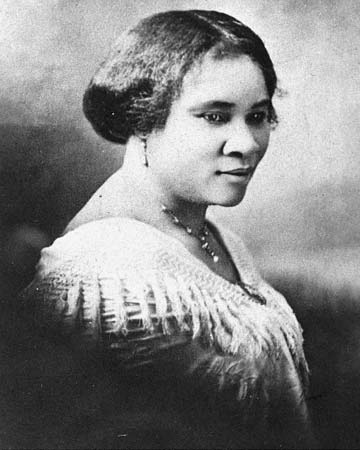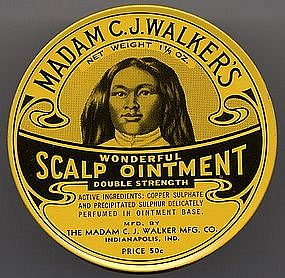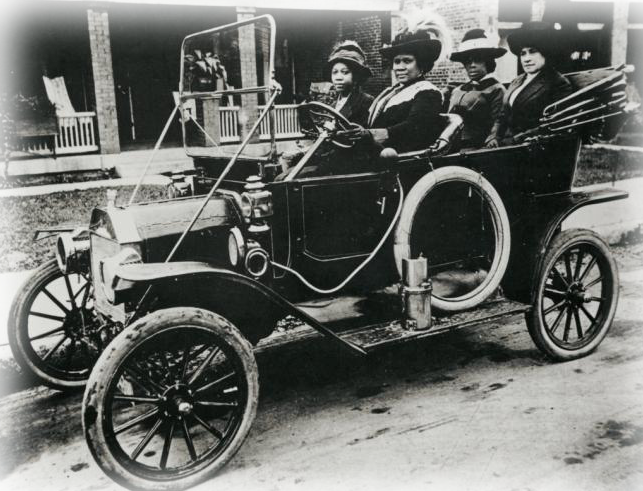 The first female self-made millionaire in U.S. history. Not too shabby a title. But I think Madam C.J. Walker—born Sarah Breedlove—gets extra points, like exponential extra points, for also having been born the daughter of slaves in the post-Civil War deep South. And still becoming a self-made millionaire. Now that takes some chutzpah.
The first female self-made millionaire in U.S. history. Not too shabby a title. But I think Madam C.J. Walker—born Sarah Breedlove—gets extra points, like exponential extra points, for also having been born the daughter of slaves in the post-Civil War deep South. And still becoming a self-made millionaire. Now that takes some chutzpah.
Sarah was born in Louisiana in 1867, not long after the Emancipation Proclamation. Thus, she was the first of her siblings to be born free. Her parents had been slaves on the Madison Parish plantation. Imagine that generational divide—the brave new world that Sarah faced in the aftermath of the Civil War. She was not a slave; but what options could possibly be open to her, as a woman, let alone a businesswoman?
Well, early on, not a lot. She married at the age of 14 and had a daughter, A’Lelia (Lelia for short) at 17. Her husband died when Lelia was two years old, and Sarah moved, daughter in tow, to St. Louis.
Sarah later remarried. Her husband was one Charles Joseph Walker (see where she got the name!), a newspaper advertising salesman. It was about this time that Sarah, now Madam C.J. Walker, got her big American business idea. Taking into account her own experiences and difficulties with her hair—hair loss from an unhealthy scalp, “kinkiness” of her ethnic hair—she whipped up her own special shampoo and tonic, which she then decided to sell to the general populace. Or at least, other African-American women.
This is, I think, a really interesting point. First of all, there is an intense politics surrounding ethnic, and in particular African-American, hair. Consider the normative follicle beauty ideal in our society, which centers on lush, shiny, long, and, importantly, smooth hair. For many women, with a bit of brushing and shampooing, this is the natural state of their hair. For many others, this is something that can only be achieved through arduous styling, product usage, and manipulation. And yet it is still expected of them, somehow. How many African-American female celebrities wear their hair “au natural”? What kind of media buzz is created when they do?
This is a problem and, judging by Madam Walker’s success, not a new one. While the politics are questionable, Walker was able to smartly fill a need in an era when the African-American woman consumer was increasing her buying power. Capitalism! Free enterprise! In 1908, Walker and her husband moved to Pittsburgh and opened a college to train “hair culturists,” then resettled in Indianapolis where Madam C.J. Walker’s hair enterprise headquarters and factory were established.
Walker wasn’t just some money grubbing capitalist, even though that was clearly the vogue at the time (see: John D. Rockefeller, Andrew Carnegie, J.P. Morgan, Henry Ford). She was also interested in politics and social causes, and regularly contributed money to the NAACP, the NACW (National Association of Colored Women), the YMCA, and other organizations. Among her pet projects: making lynching a federal crime (one of those things where you look back and are like: HOW WAS THIS AN ISSUE WITH TWO SIDES), the education of young black people (she sent six students every year to Booker T. Washington’s Tuskegee Institute), saving Frederick Douglass’s house (!!).
Then, like any self-respecting upwardly mobile American, she built her own estate, and moved into it. In 1917, she relocated to Villa Lewaro, designed by the first licensed black architect in New York state, in Irvington-on-Hudson, New York. According to her New York Times obituary, the estate was three stories and had over thirty rooms. It also had an $8,000 organ, which, after a well-stocked floor-to-ceiling mahogany library, would be the first thing I would get as a millionaire too.
Madam C.J. Walker died in 1919 at the age of 51, many more years of fabulous hair-empire-running and nouveau-riche-living before her unrealized. Her daughter Lelia took over the company upon her death. In 2010, New York City named a street (or technically, a “place”) in Manhattan after the two of them.
I love how Madam Walker resides at this fascinating intersection of race, class, and gender—capitalizing on raced and gendered products, born into the aftermath of America’s worst raced sin, giving large sums of her substantial fortune towards the advancement of its victims. I admire her gumption (synonym to chutzpah) at the same time that I recognize that her ability to navigate post-bellum America’s racist, unabashedly capitalist system was unique and exemplary. She made it. Most people didn’t.



